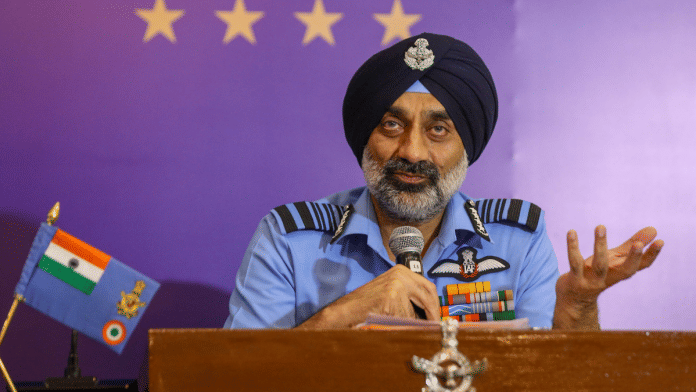New Delhi: Speaking for the first time about Operation Sindoor kills, Indian Air Force (IAF) chief Air Chief Marshal A P Singh Saturday said India’s S-400 Triumf air defence system had shot down five Pakistani fighter jets in the air along with an AEW&C/ELINT aircraft at a distance of about 300 kilometres, the longest surface-to-air kill recorded in history.
He further said that some parked F16s under maintenance at the Jacobabad air base were also damaged while one Saab Erieye, an airborne early warning and control (AEW&C) aircraft, was destroyed at the Bholari air base.
Calling the S-400 a “game-changer”, the IAF chief, who was speaking at the Air Chief Marshal LM Katre lecture in Bengaluru, said, “We have at least five fighters confirmed kills and one large aircraft, which could be either an ELINT aircraft or an AEW&C aircraft, which was taken on at a distance of about 300 kilometres. This is actually the largest ever recorded surface-to-air kill that we can talk about.”
The IAF chief added that the Shahbaz Jacobabad airfield was one of the major airfields that was attacked.
“There’s an F-16 hangar here. One half of the hangar is gone. And I’m sure there were some aircraft inside, which got damaged. We were able to get at least two command and control centres, like Murid and Chaklala. At least six radars, some of them big, some of them small…We have an indication of at least one AEW&C in that AEW&C hangar and a few F-16s, which were under maintenance there…” he said.
ThePrint was the first to report on 8 May that the S-400 system had seen action for the first time during Operation Sindoor. Information related to actual kills was then held back since the IAF was still in the process of analysing the technical inputs.
All the five fighter aircraft along with the AEW&C/ELINT were shot down on 7 May, sources had then told ThePrint.
Sources said the identity of the fighter aircraft was discerned based on the signature and they are all of Chinese origin. No F16s were shot down in the air, as per preliminary inputs.
The other aircraft shot down at a distance of about 300 kilometres was a slow moving large aircraft which could have been the Saab Erieye, an airborne early warning and control (AEW&C)aircraft, or the Chinese-made electronic intelligence (ELINT) and electronic warfare (EW).
‘Ghost of Balakot’
ACM Singh said “it was a high-tech war that was fought”.
“In 80 to 90 hours of war, we were able to achieve so much damage that it was clear to them that if they continue, they are going to pay for it more and more. So they came forward and sent a message to our DGMO that they wanted to talk. This was accepted on our side.”
Expressing disappointment at those who questioned IAF’s efficacy in 2019, he said that in Balakot, the force could not get anything from inside. “It became a big issue trying to tell our own people, unfortunately, as to what we have been able to achieve. We had intelligence of what had gone on inside, had human kind of intelligence where we had a very clear picture of huge damage.
“There have been so many terrorists who have been neutralised, but we could not convince our own people that, look, we have achieved that…So I’m very happy that this time we were able to take care of that ghost of Balakot, that we were able to tell the world what we have achieved,” the IAF chief said, showing satellite imagery and local media videos of the damage caused.
“If you see satellite pictures, all one can see are pin pricks which are entry points of penetration missiles just like in Balakot, but this time because of the local media there, one could see the inside damage,” he added.
Talking about air defence, ACM Singh said none of the Pakistani aircraft could come anywhere near the boundaries of Akash and even MRSAM.
“All their aircraft were taken on by LRSAM because they were trying to stay away, but still they were within our range at times, and that is the opportunity targets that we got. As far as our offensive was concerned, that night we didn’t have any hold back and we decided that we would go attack at the front, we would stretch their resources.”
“The idea was once again not to attack one particular airfield and decimate that airfield. The idea was to give him that feeling or give him that indication that look, we can attack you deep inside, at will, wherever we want to…Bholari, an AEW&C hangar, was attacked. And here we have a very clear hint that there was an aircraft in sight when this attack took place…” ACM Singh further said.
Talking about strikes on the Sargodha airbase of Pakistan, he said, “We’ve grown up in our Air Force, dreaming about days like this, someday we’ll get a chance to go there. So it just so happens that I got my chance just before I retired… So we took on the airfield there…”
He added that India’s air defence systems did a wonderful job. “The S-400 system, which we had recently bought, has been a game-changer. The range of that system has really kept their aircraft away from their weapons like, those long-range glide bombs that they have, they have not been able to use any one of those because they have not been able to penetrate the system,” he said.
(Edited by Gitanjali Das)






